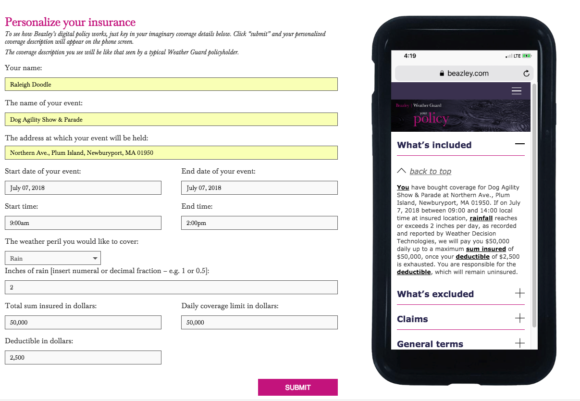Specialist insurer Beazley has launched a digital insurance policy in the U.S. that can be customized and describes in plain English precisely what coverage the customer has bought.
Beazley Weather Guard protects U.S. event organizers against the effects of severe weather that may cause the cancellation of an outdoor event. It can also be used by U.S. retailers to insure weather-related sales promotions, linking a sales refund to an unusual weather event.
The easy-to-submit form allows applicants to choose the type of coverage, peril (rain, snow and temperature), trigger level and duration of the coverage. Beazley offers limits up to $5 million. It will cover most events except those offshore or at high altitude, according to Beazley contingency underwriter Christian Phillips.
Phillips told Insurance Journal the insurer can produce most premium quotes within an hour of receiving the form. Very complex risks may take longer.
According to Beazley, to develop the product its underwriters tapped into a database with more than four decades of meteorological data from more than 5,500 weather stations worldwide to develop the program.
Beazley uses Oklahoma-based Weather Decision Technologies as the arbiter of whether the trigger level such as inches of rain or snow or wind velocity has been met.

The new simple language digital policy, which can be accessed on a mobile device, describes precisely and exclusively the coverage purchased. The first sentence of each policy spells out the trigger for coverage, together with the sum insured in dollars and any self-insured deductible.
Phillips explained that for someone who bought a Beazley Weather Guard policy to protect a planned event against heavy snow would specify “snow” and explain how many inches of snow will trigger coverage. If the covered peril is excessive heat or cold, the policy will explain how high or low the temperature needs to be to trigger coverage. “It’s entirely personalized,” he said.
The digital policy transforms the standard insurance policy that is typically written on paper or as a pdf document and includes both a declarations page summarizing the coverage and a much longer, standard policy wording that shows all possible forms of available coverage, including coverage not purchased.
Beazley has integrated the two parts of the Weather Guard policy into a personalized digital (HTML) document that is far shorter and easier to understand.
“Insurers have generally struggled with plain English policy wordings,” said William Pitt, Beazley’s chief marketing officer. “Traditional policies are one-size-fits-all documents that describe every possible form of coverage the policyholder might have bought. To remind yourself of what you actually have bought, you have to constantly flick back to the declarations page.
“We asked ourselves: What would happen if all the information on the declarations page was instead integrated into the policy wording itself? When we did this, we found that it made the policy much easier to understand. Instead of ‘named insured,’ we could insert the actual name of the policyholder. Instead of ‘sum insured,’ we could insert a dollar amount. It all became much less abstract.”
According to Pitt, Beazley’s digital Weather Guard policy has two other major advantages over paper-based insurance policies:
Paper-based policies have, often lengthy, sections containing all the definitions used in the policy. In order to understand the coverage, the policyholder must constantly consult the alphabetical list of definitions. This chore is eliminated in the digital Weather Guard policy: any definition can be viewed by clicking on the defined term.
Changes made mid-term to paper-based policies are recorded in endorsements that are appended to the policy. In the digital policy, the change can be incorporated immediately into the policy wording, ensuring that the coverage described in the wording is always up to date.
Phillips sees it being used by businesses, municipalities, schools and other organizers scheduling events of all sizes including fairs, concerts and parades. Others with interest include water parks, zoos, golf courses, outdoor restaurant seating areas and rooftop bars.
Beazley’s marketing materials suggest several uses for the Weather Guard product. A hotel could reimburse guests or give them vouchers for another stay if the weather during their stay was bad. A retail jeweler or florist might offer customers money back on a purchase if the weather hits pre-agreed benchmark such as an unusually hot Valentine’s Day. Also, a municipality might protect itself against higher than expected clean-up costs from unusually high snowfall.
Although the policy is simple, customers must still go through a broker to obtain a policy from Beazley.
The insurer has made a demonstration version of Beazley Weather Guard available online. The demo is not a purchasing app; it serves to show the internal system that generates the simplified policy language.
Topics USA
Was this article valuable?
Here are more articles you may enjoy.


 Billionaire NFL Owner Suing Over Billboards Near His LA Stadium
Billionaire NFL Owner Suing Over Billboards Near His LA Stadium  Adjusters Launch ‘CarFax for Insurance Claims’ to Vet Carriers’ Damage Estimates
Adjusters Launch ‘CarFax for Insurance Claims’ to Vet Carriers’ Damage Estimates  Warburg Mulls $1 Billion Sale of London Insurance Broker McGill
Warburg Mulls $1 Billion Sale of London Insurance Broker McGill  CEOs on Guard as Trump Rattles Companies With Series of Edicts
CEOs on Guard as Trump Rattles Companies With Series of Edicts 

